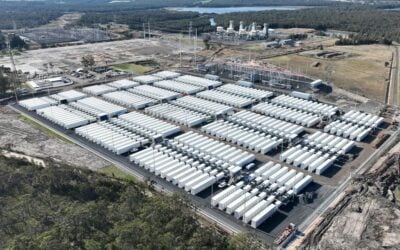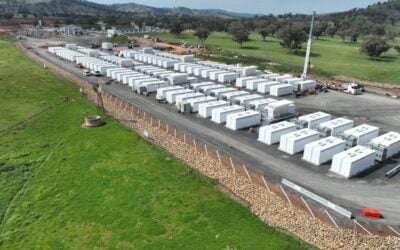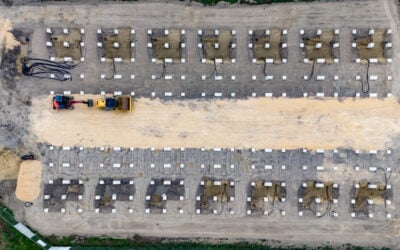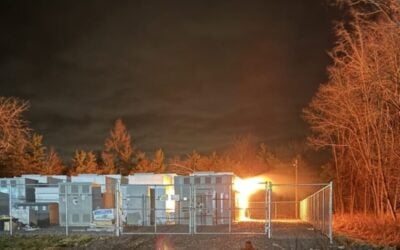
Supporting New York’s state goals of reaching 3,000MW of energy storage by 2030 – equivalent to 40% of today’s electric demand – codes for the safe installation of energy storage systems (ESS) will go into effect on a permanent basis after 1 November.
The issue of fire safety in relation to the deployment of stationary energy storage systems in New York, particularly in the US state’s densely populated urban areas, has been considered to have held back what has otherwise been a hugely fertile state for clean energy. New York State Energy Research and Development Authority (NYSERDA) statistics showed that as of September this year there were only 51 installed ESS in New York (not including New York City) with a total storage capacity of 74,600kWh.
Energy-Storage.news recently spoke with NEC, provider of the state’s first, 20MW, grid-scale battery system and Key Capture Energy, the project’s developer. Both parties said that there had been a lot of work to do in getting that ESS up and running, including a great deal of work in close partnership with the Fire Department. NEC’s Roger Lin also said that he had been one of around 50 industry stakeholders to have contributed to the US National Fire Protection Association (NFPA) draft energy storage standards, published in September this year.
In June, the New York State Department of State issued its 2019 Energy Storage System Supplement which included amendments to the New York State Uniform Fire Prevention and Building Code, as well as pertinent amendments to the 2015 International Fire Code and 2015 International Building Code, both widely used across the world and now adding relevant definitions for different energy storage system technologies and terms.
Try Premium for just $1
- Full premium access for the first month at only $1
- Converts to an annual rate after 30 days unless cancelled
- Cancel anytime during the trial period
Premium Benefits
- Expert industry analysis and interviews
- Digital access to PV Tech Power journal
- Exclusive event discounts
Or get the full Premium subscription right away
Or continue reading this article for free
Fire Department takes lead on issuing guidance
At the beginning of October, the Fire Department issued guidance on the design, installation and emergency management procedures for outdoor stationary storage battery systems, noting that “various highly-publicised incidents have illustrated the fire safety concerns associated with lithium-ion batteries. In addition to lithium-ion, the new stationary storage battery technology includes nickel-cadmium, nickel metal hydride and flow batteries,” the Fire Department’s rule said.
The document also set forth system size thresholds for different battery system types, as shown below:
| Battery Technology | Aggregate Rated Energy Capacity | ||
|---|---|---|---|
| Small | Medium | Large | |
| Lead Acid | >2kWh and <70kWh | >70kWh and <500kWh | >500kWh |
| Ni-Cd | >2kWh and <70kWh | >70kWh and <500kWh | >500kWh |
| NiMH | >2kWh and <70kWh | >70kWh and <500kWh | >500kWh |
| Li-ion | >2kWh and <70kWh | >20kWh and <250kWh | >250kWh |
| Flow | >2kWh and <70kWh | >20kWh and <500kWh | >500kWh |
Permits are required for medium and large battery systems from the Fire Department. A holder of a Fire Department-issued certificate also needs to remain accountable and responsible for the system, particularly in the event of emergency response. That holder of a Certificate of Fitness also remains responsible for commissioning and decommissioning (end-of-life) for the system(s).
In place until the 1 November, from when it will be basically made permanent in a final form following an ongoing comment period, the Fire Department said that “ensuring a minimum level of safety of such systems in buildings is a critical part of protecting the public, building occupants, and emergency responders.”
The Emergency Rulemaking basically said the guides for best practise outlined in the Department of State’s Supplement referred to above should be adhered to, while acknowledging that there could be an “initial cost increase associated with this rule”: systems of more than 50kWh capacity and those designed to be installed within close proximity of one other (within three feet) should undergo UL 9540A testing, which itself can cost between US$30,000 and US$50,000. Battery system manufacturers are likely to be liable for paying this test fee, while for systems over 50kWh, the ESS manufacturer is likely to pay test fees “within the range of US$60,000 to US$80,000”.
Both the Emergency Rulemaking and the permanent Notice of Adoption to be in place after the beginning of November have been posted online by law firm Hodgson Russ and made available to view as a pdf on its website.





